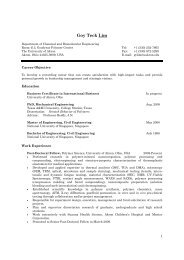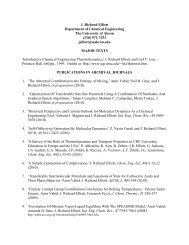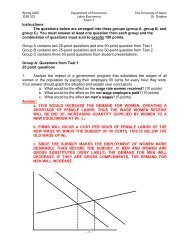Sociology of the Anarchists - Gozips.uakron.edu - The University of ...
Sociology of the Anarchists - Gozips.uakron.edu - The University of ...
Sociology of the Anarchists - Gozips.uakron.edu - The University of ...
Create successful ePaper yourself
Turn your PDF publications into a flip-book with our unique Google optimized e-Paper software.
Chomsky quotes Octave Mirbeau: “anarchism has a broad back, like paper it endures<br />
anything” (Chomsky, date, p). This flexibility, bleeds into action. Thus, active anarchists<br />
can be a part <strong>of</strong> an anarchist “movement” without actual participation in anarchist<br />
organizations. By applying <strong>the</strong>ir anarchist convictions, <strong>the</strong>y are essentially being active<br />
participants in a movement that seeks <strong>the</strong> dispersion <strong>of</strong> liberation and freedom. This is<br />
especially true when viewing anarchism from <strong>the</strong> “yardstick model” (see Appendix). <strong>The</strong><br />
yardstick model frames anarchism as a reference point to be applied to all situations and<br />
conditions, not as a pre-determined holy writ.<br />
Inside anarchist circles, however, <strong>the</strong>re is disagreement amongst <strong>the</strong>mselves whe<strong>the</strong>r or<br />
not <strong>the</strong>y are a “movement”. [List examples and references] Thus, most contention<br />
around <strong>the</strong> “movement” issue revolves around <strong>the</strong> raw number <strong>of</strong> anarchists, <strong>the</strong> idea <strong>of</strong><br />
“critical mass”, and <strong>the</strong> effectiveness <strong>of</strong> anarchist tactics and campaigns. <strong>The</strong> reader is left<br />
to make up <strong>the</strong>ir own mind on <strong>the</strong>se questions.<br />
Reflect on Vasi, et al. (2003) re: <strong>the</strong> “mobilizer's dilemma”<br />
Present academics—particularly historians—will occasionally study anarchists, yet <strong>the</strong><br />
vast majority are long dead and gone. <strong>The</strong>y study Peter Kropotkin not Noam Chomsky 36 ,<br />
Emma Goldman not Starhawk, Joseph Labadie not Murray Bookchin, or Alexander<br />
Berkman not Jaggi Singh. <strong>Anarchists</strong> scholars primarily outside <strong>of</strong> <strong>the</strong> academy are <strong>the</strong><br />
only ones who make a studious effort to better understand <strong>the</strong> roots <strong>of</strong> what historian<br />
Howard Zinn (1997) calls “surely one <strong>of</strong> <strong>the</strong> most important political philosophies <strong>of</strong><br />
modern times” (p. 644). George Woodcock was one <strong>of</strong> <strong>the</strong>se scholars. Since Woodcock's<br />
death in 1995, <strong>the</strong> academic mantle <strong>of</strong> Anglo-anarchist historical studies has been handed<br />
<strong>of</strong>f to Paul Avrich. But what <strong>of</strong> <strong>the</strong> non-historical realm <strong>of</strong> anarchist study?<br />
What follows is an attempt to integrate North American anarchism as a social movement<br />
into <strong>the</strong> existing framework <strong>of</strong> sociology research and <strong>the</strong>ory. <strong>The</strong> North American strain<br />
differs from o<strong>the</strong>rs around <strong>the</strong> world. Still, <strong>the</strong>re are many incredible examples <strong>of</strong> non-<br />
North American/Western European anarchism, including Fernandez (2001), Mbah and<br />
Igariwey (1997), and Adams (year?). Klein (2000a) observes that <strong>the</strong> majority <strong>of</strong> young<br />
Czech and Eastern European activists battling global capitalism, are disgusted with both<br />
state “socialism” and Western capitalism, thus compelling <strong>the</strong>m to identify as anarchists.<br />
Even though deceased anarchists and past anarchist organizations will be used as<br />
examples, primary focus will rest upon <strong>the</strong> present-day anarchist movement essentially<br />
invisible to contemporary sociologists.<br />
Using David Aberle's 1966 pivotal classification <strong>of</strong> social movements, anarchism falls<br />
clearly in <strong>the</strong> “transformative movement” category. <strong>The</strong> o<strong>the</strong>r three categories social<br />
movements according to Aberle are reformative, redemptive, and alternative. Aberle<br />
1966. (or “resistance/regressive movements”? -- in Kendall 1999) Tilly describes<br />
36 Noam Chomsky refers to Peter Kropotkin as <strong>the</strong> (unrecognized) founder <strong>of</strong> “sociobiology”. Chomsky,<br />
himself probably <strong>the</strong> most influential living anarchist, has heralded Kropotkin's notion <strong>of</strong> “mutual aid”.<br />
[ Williams 45 ] [ this is a draft. do not cite. ]






